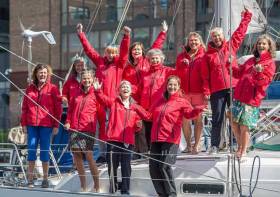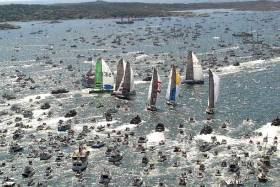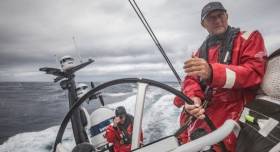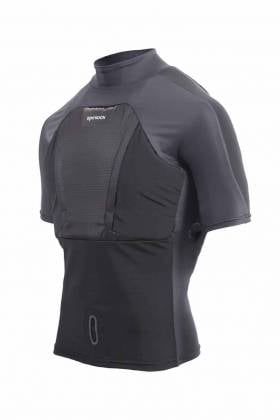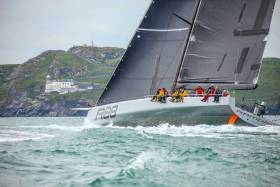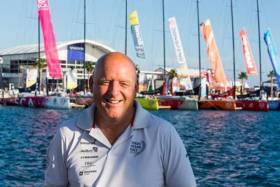Displaying items by tag: Volvo Ocean Race
The Terror of Iceberg Watching on an Offshore Yacht
One of the things I have done in my life is an iceberg watch on the bow of an offshore yacht racing in the Atlantic during the dark hours of night, keeping an eye out for ‘growlers’.
These are small chunks of floating ice that may only be barely visible above the surface of the water, perhaps a foot or two. They could do quite a bit of damage to a yacht. I was on the 83ft NCB Ireland at the time, racing across the Atlantic from Fort Lauderdale to Southampton.
It was the final leg of the 1989/1990 Round the World Whitbread Race, now named the Volvo Race. Because of the variety of weather conditions encountered on that leg, it was a microcosm of the entire race, quite rough and touch and benign at varying times. Somewhere around the cold Labrador Current which flows from the Arctic Ocean south along the coast of Labrador and passes around Newfoundland, continuing south along the east coast of Nova Scotia, a continuation of the West Greenland Current and the Baffin Island Current that meets the warm Gulf Stream at the Grand Banks southeast of Newfoundland, I learned about “iceberg watching” from the NCB crew! It was cold at night, but the warmth of the ‘nav station’ with radar sweeping around seemed to be where “iceberg watching” was done, so I thought that would be ok, only to find my watch was not there but on deck, in the cold, looking for “growlers”. In spring and early summer, when NCB was crossing the Atlantic the Labrador Current transports icebergs from the glaciers of Greenland southwards into the trans-Atlantic shipping lanes.
All that came back to mind this week when I heard Angela Heath, then Angela Farrell from Dun Laoghaire, describe “iceberg watching” as “terrifying”. Indeed, you didn’t know whether to call an alarm or hope that what you saw in the dark was only another wave.
Angela had done “iceberg watching” in much tougher waters in that race – the Southern Ocean – crewing on the all-women’s yacht, Maiden. That 58 ft. British boat was skippered by the legendary Tracy Edwards, then 27 years old and set a new level for women’s participation in sailing. This is the 30th anniversary year of Maiden’s trailblazing achievement which is the subject of a film documentary in the cinemas by Director Alex Holmes. Maiden changed the view of women in world sailing and Angela is still committed to that approach as part of Irish Sailing’s campaign to encourage more participation by women in sailing. Angela helmed the yacht ‘Crazy Horse’ in the Pathfinder Women At The Helm’ regatta in Dun Laoghaire where 200 sailors raced in 61 boats.
She was talking on my radio programme, This Island Nation, to my colleague Justin Maher. I was transfixed listening to her description of sailing on Maiden and “iceberg watching” and how, after having a family, she returned to sailing and how important the ‘Women at the Helm’ programme is.
She concluded her piece with the words about sailing: “Go and do it, it’s so good for you.”
It would be hard to find a better description of the lure, the attraction of our sport. It’s worth listening to.
• Listen to Angela Heath on the Podcast below where she starts by describing what ocean offshore racing is like.
To celebrate Volvo Car Ireland’s sponsorship of the Volvo Round Ireland 2018, Volvo is offering some lucky person the very special opportunity to win a trip for two to witness the penultimate leg of the Volvo Ocean Race 2017-2018 in Gothenburg.
The Volvo Ocean Race is scheduled to stopover in Gothenburg in mid-June 2018. And of course, Gothenburg is the home of Volvo. This is where it all began for Sweden’s most iconic and loved brand – and Sweden doesn’t get much more Swedish than Gothenburg.
The prize includes two nights’ accommodation in a four star hotel for two people, dinner on both nights, and a tour of the Volvo Ocean Race village.
To enter, all you have to do is sign up for a Volvo test drive via the Round Ireland website here before the 4th of May. The winner will be announced on May 7th.
Volvo Ocean Race Team Sun Hung Kai/Scallywag Issue Timeline of Events Leading to Loss of John Fisher
The crew of Volvo Ocean Race entry Team Sun Hung Kai/Scallywag has put together a timeline of events to ensure accurate reporting on the incident and it follows here:
On Monday 26 March, Team Sun Hung Kai / Scallywag lost John Fisher overboard in the Southern Ocean, approximately 1,400 nautical miles west of Cape Horn.
Despite conducting an exhaustive search in gale force conditions, he has not been recovered.
"This is the worst situation you can imagine happening to your team," said SHK/Scallywag Team Manager Tim Newton, who has spoken with skipper David Witt and navigator Libby Greenhalgh about what happened on Monday.
"We are absolutely heart-broken for John's family and friends. I know for David, he has lost his best friend. It's devastating."
Newton says he asked the crew to put together a timeline of events to ensure accurate reporting on the incident and it follows here:
- On Monday, 26 March, SHK/Scallywag was racing in Leg 7 of the Volvo Ocean Race from Auckland, New Zealand to Itajai, Brazil, approximately 1,400 nautical miles west of Cape Horn
- Weather conditions were 35-45 knots with 4 to 5 metre seas with showers reducing visibility. It was 15 minutes before sunrise
- The team was sailing with a single reef in the mainsail and the J2 jib. The Fractional 0 (FR0) sail was hoisted but furled
- At roughly 1300 UTC SHK/Scallywag surfed down a large wave leading to an accidental crash gybe
- John Fisher was on deck, in the cockpit. At the time, he was moving forward to tidy up the FR0 sheet and had therefore unclipped his tether
- As the mainsail swung across the boat in the gybe, the mainsheet system caught John and knocked him off the boat. The crew on board believe John was unconscious from the blow before he hit the water
- He was wearing a survival suit with a wetsuit hood and gloves and a lifejacket
- The JON buoy and the horseshoe buoy were thrown off the back of the boat to mark the position
- It took some time to get the boat under control and motor sail back to a position near where the man overboard occurred
- At 1342 (UTC), the team informed Race Control, by email, that there was a man overboard and they were returning to the MOB position to start a search pattern
- With input from the Maritime Rescue Coordination Centre and Race Control in Alicante, a search and rescue operation was carried out for several hours but there was no sign of John, the horseshoe buoy, or the JON buoy
- With weather conditions deteriorating, a difficult decision was taken to abandon the search and preserve the safety of the remaining crew
Newton says the team is distraught but has a clear focus on getting the crew and boat back to shore.
Spinlock Reveal Volvo Ocean Race Gear at Boot Dusseldorf
Spinlock – the award-winning designers and manufacturers of rope-holding equipment and personal safety products for water users – will be exhibiting exciting new Volvo Ocean Race products at the world-renowned boat show in Dusseldorf, from the 20th – 28th January 2018.
A European debut, Spinlock will be displaying their greatly anticipated Custom Volvo Ocean Race edition Deckvest and Beacon Waist Pack at the event. This is an exciting opportunity for the public to find out all about the cutting-edge technology used in the Volvo Ocean Race. Designed with both ease of use and safety in mind, the custom edition of Spinlock's Deckvest is ISO12402 approved and has a buoyancy of 170N. As well as being lightweight and comfortable to wear, the product has a quick release manual harness attachment point that allows users to release connection in an emergency. With a double touch outer cover, the Deckvest is durable and can therefore withstand the demands the Volvo Ocean Race.
The Volvo Ocean Race Deckvest has been produced specifically with the competing sailors in mind - their personal requirements, ideas and feedback were taken into account to develop the finished product. Challenging the historically bulky and restrictive safety equipment of the past, the experts at Spinlock wanted to produce something that allows for enhanced performance.
 The Volvo Ocean Race Deckvest has been produced specifically with the Volvo Ocean Race sailors in mind - their personal requirements, ideas and feedback were taken into account to develop the finished product
The Volvo Ocean Race Deckvest has been produced specifically with the Volvo Ocean Race sailors in mind - their personal requirements, ideas and feedback were taken into account to develop the finished product
Also developed to assist the Volvo Ocean Race crews, the Custom Beacon Waist Pack ensures sailors have easy access to essential, life-saving items at all times. An innovation in managing three pivotal safety items – the Ocean Signal MOB1 AIS device, Ocean Signal PLB1 and ACR strobe – the Beacon Waist Pack has easy-to-find pockets for equipment. It allows devices to be identified, deployed and activated easily in a hurry - even in the dark or with gloved hands. The devices are tethered to the waist belt safety pack and float in neoprene covers. The whole pack floats and can be thrown to a man overboard.
Volvo Ocean Race Boatyard Spares and Logistics Manager Abby Ehler said: "Safety is a critical element in the Volvo Ocean Race, and not only does personal safety equipment need to meet specific safety requirements, it is required to be functional and comfortable to wear." She adds: "Up until now lifejackets have generally been designed for the recreational sailor, resulting in cumbersome and limiting design factors, so it is fantastic to see Spinlock's enthusiasm to design a tailor-made product meeting the specific needs of the competitive offshore sailor."
Additionally, Spinlock's streamlined personal flotation device (PFD) – the AeroPro – will be exhibited. A product of another technical partnership – this time with British America's Cup Challenger, Land Rover BAR – the AeroPro is designed for high agility dinghy, multihull and keelboat sailing. It is a body profiled 50N flotation vest that employs the latest durable high stretch woven fabrics, expertly shaped to the body, ensuring a clean and ergonomic shape. The robust fabrics in key wear areas give the necessary protection and the close-fitting neck collar, sleeves and over length waist gaiter help to reduce wind and water resistance, ensuring it is as aerodynamically efficient as possible.
James Hall, Marketing and Sales Manager at Spinlock said: "Everyone here at Spinlock is greatly looking forward to this exciting event. Our presence at Dusseldorf will provide us with a valuable opportunity to showcase some of our most innovative products and build upon our already excellent reputation in the industry."
Visitors will find Spinlock in Hall 11, stands H25-H39. They will be hosting a drinks reception on Friday 26th January at 6pm to showcase the latest equipment and clothing used in the Volvo Ocean Race.
2018 – Will This Be Irish Sailing’s 'Year of Years'?
At least two different viewpoints may be taken on the remarkable and very long history of sailing in Ireland. Either you see it as a wonderful heritage, which should be celebrated with gala anniversaries, and whatever you’re having yourself, at every possible opportunity. Or else you might sadly admit that it’s a burden, a deadening load on all of us which stultifies development, restricts fresh thinking, and railroads the annual programme into a traditional pattern sailed in vintage boats which allows very little space for something with the instant appeal and intrinsic excitement of novelty.
But perhaps there’s a happy place somewhere in between, a thoughtful place among many events, where we can live comfortably with some astonishingly old throwbacks to the distant past, yet continue to modify the programme and our way of doing things in order to accommodate new ideas. And with any luck, we might somehow find space to come up with some bright ideas of our own to add to the rich and very varied tapestry of the world sailing scene. W M Nixon casts an eye over next season’s programme to see what it might bring to the party.
After the excitement of Annalise’s Silver Medal in Rio on August 2016, in 2017 there was a generally unstated but definite feeling that we were due a down-home year, a year when sailing in Ireland in all its quirkiness would be celebrated, and anything with a non-Olympic flavour would be given every encouragement to flourish.
Yet at the beginning of 2017, who could have predicted that as summer approached, it would be Annalise herself who would up-sticks from the pre-ordained Olympian way of doing things, and plunge into the maelstrom which is Volvo Ocean Racing?
 Olympic Medallist Annalise Murphy with her parents Cathy MacAleavey and Con Murphy. As the establishers of a long-standing Round Ireland Record in 1993, Cathy and Con are well aware of what Annalise has faced in taking on a round-the-world crewing job in the Volvo 65 Turn the Tide on Plastic (below)
Olympic Medallist Annalise Murphy with her parents Cathy MacAleavey and Con Murphy. As the establishers of a long-standing Round Ireland Record in 1993, Cathy and Con are well aware of what Annalise has faced in taking on a round-the-world crewing job in the Volvo 65 Turn the Tide on Plastic (below)

Successful predicting doesn’t get any easier, even with detailed programes taking shape. Annalise’s progress in the rugged ocean racing world this will be continuing until the finish in June 2018, but thanks to the Volvo Race’s flexible approach to crewing arrangements, she will be able to opt out for long enough to get herself back into the Olympic Women’s Radial Laser mode from time to time to keep in touch for the big Tokyo 2020 Olympics countdown event in early August 2018, the two-week Hempel World Sailing Championship at Aarhus in Denmark.
There, with 40% of places up for grabs, many other Irish Olympic wannabees will be progressing after long and often lonely months and even years of doing the circuit. By then, several of them such as Aoife Hopkins will have thoroughly tested the waters in the Olympic Classes, starting with the Championships in Florida in January.
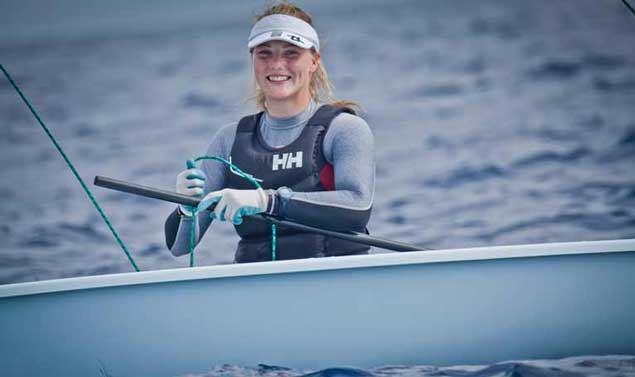 Aoife Hopkins of Howth and Trinity College will be starting her 2018 campaign towards the 2020 Tokyo Olympics in Florida in January
Aoife Hopkins of Howth and Trinity College will be starting her 2018 campaign towards the 2020 Tokyo Olympics in Florida in January
February sees action at home and abroad with the growing enthusiasm for Team Racing in action with the Trinity Varsities up on the lake at Blessington on Friday 9th/Saturday 10th February, which will fit them neatly around the Irish Sailing/Afloat.ie “Sailor of the Year 2017” awards ceremony back down in Dublin at the RDS on the evening of Friday February 9th, where an exceptionally eclectic group of maritime high-flyers will gather to receive well-deserved praise for many remarkable - indeed, in some cases astonishing - achievements.
But late February will also see serious international racing on the other side of the Atlantic with the increasingly popular annual RORC Caribbean 600 starting from Antigua on Monday 19th February. There’ll be a strong Irish contingent, and we have form here, as Adrian Lee’s Cookson 50 Lee Overlay Partners from Dun Laoghaire won the first Caribbean 600 in 2009, then Conor Fogerty’s Sunfast 3600 Bam! from Howth won her class in 2016, and in 2017 it was all back on top again, as the overall winner, Hap Fauth’s Maxi72 Belle Mente, was navigated by our own Ian Moore.
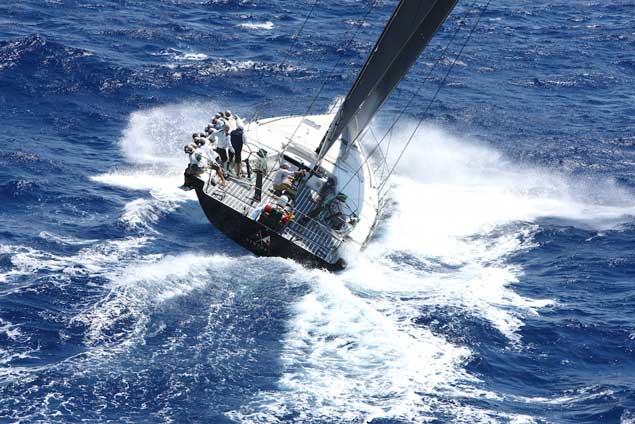 Bella Mente on her way to winning the RORC Caribbean 600 in February 2017, navigated by Ian Moore. There will be a strong Irish presence in 2018’s race, starting at Antigua on 19th February. Photo Tim Wright
Bella Mente on her way to winning the RORC Caribbean 600 in February 2017, navigated by Ian Moore. There will be a strong Irish presence in 2018’s race, starting at Antigua on 19th February. Photo Tim Wright
However, February at home in Ireland for most sailors is conference time, and the ever-expanding annual Irish sailing Cruising Conference is scheduled for Saturday February 17th at the Clayton Hotel in Leopardstown in Dublin, the move to a Clayton Hotel’s conference facilities having started last year in Cork when bookings were so heavy they’d to change the venue from the original choice of the Port of Cork HQ Building.
Nevertheless those dedicated team racers in school and college are also maximising their use of February before exam countdowns take over everyone’s timetable, and there’s the Leinster Schools at RStGYC on February 17th, while the following weekend is the big one, the Irish Universities Championship. In 2017 they had Clifden as a very successful venue in an early weekend in March, in 2018 they’re pushing the early season envelope even further by using the weekend of 22nd-24th February, and the venue is again in the west, this time at Kilrush, County Clare.
 Springtime sunshine at Clifden in Connemara, March 2017, for the Irish Universities Championship. In 2018, the event will be even earlier – on February 24-25th at Kilrush in County Clare
Springtime sunshine at Clifden in Connemara, March 2017, for the Irish Universities Championship. In 2018, the event will be even earlier – on February 24-25th at Kilrush in County Clare
Thus we reach the end of February with the season already well under way for some specialists, but mainstream sailors will still be in a different time-scale, and in March the first one for the diary is Irish Sailing’s AGM on Saturday 10th March, venue still to be confirmed. However for those who insist that sailing shouldn’t miss any month of the Irish year, the Royal Cork’s famous come-all-ye dinghy festival, the PY1000, is slated in for Sunday March 11th, and it’s quite something, in fact it’s fantastic.
It would be impossible to imagine contemporary Irish sailing without the Laser, that ageless wonder which has contributed so much to our sport since it first appeared here around 1970. Yes, 1970. To be completely accurate, the Laser will be having its Golden Jubilee in 2019, as the prototpypes and first production boats sailed in 1969, so when our first major Laser event of 2018 gets going, the Munsters at Baltimore on March 31st/April 1st, it will be part of a growing celebration which in 2018 will culminate in Ireland in the mega-fleet World Lasers Masters (we’re talking maybe 400 boats) in Dun Laoghaire in a joint NYC/RStGYC venture from 7th to 17th September 2018. That will be a joyous affair to bring Dun Laoghaire Harbour to an upbeat mood as the traditional sailing season draws to its close after a fascinating main programme in the central part of the 2018 summer, with various pillar events the highlights in a continuous and colourful tapestry which takes in every part of the country.
 Lasers – it’s part of what we are. This classic dinghy is still as new as tomorrow, yet it’s now on the count-down to the Golden Jubilee in 2019-2020, and a significant part of that will be the World Laser Masters in Dun Laoghaire from 7th to 17th September 2018, with a huge fleet expected.
Lasers – it’s part of what we are. This classic dinghy is still as new as tomorrow, yet it’s now on the count-down to the Golden Jubilee in 2019-2020, and a significant part of that will be the World Laser Masters in Dun Laoghaire from 7th to 17th September 2018, with a huge fleet expected.
That “traditional season” will have seen solid regulars such as the annual programme of the steadily-expanding Irish Sea Offshore Racing Association into action by late April (first races are on April 21st), by which time the Irish Sailing’s Youth Pathway Nationals – 2017 was the biggest yet seen when it was at Ballyholme – will have been staged from 5th to 8th April at a venue yet to be confirmed. And Ireland’s long history of team racing will have been acknowledged yet again, this time with the 70th Anniversary of the senior of them all, the Royal St George series in Dun Laoghaire on April 22nd/23rd. Believe me, over those seventy years, just about everybody in Irish sailing seems to have been a participant in some way or other in this grandaddy of team events.
Into May, and the 12th to 18th sees the Asgard II Tall Ship Reunion Voyage in the Irish Sea on the Tall Ship Pelican, followed by a Gala Ball which will show that although the Asgard II was sadly lost ten years earlier in September 2008 when she sank, her spirit and those who sailed on her lives on, and an Irish tall Ship will sail again.
 The much-lamented Sail Training Brigantine Asgard II was lost in September 2008, but the tenth anniversary of this sad event will see a renewal of the determination to find an appropriate replacement
The much-lamented Sail Training Brigantine Asgard II was lost in September 2008, but the tenth anniversary of this sad event will see a renewal of the determination to find an appropriate replacement
In May the core pace of mainstream sailing is hotting up, though while you might get sunshine, pure heat is still in short supply in Scotland in the Springtime with snow sometimes still on the mountain-tops for the Scottish Series at Tarbert in late May. But this has long been a happy hunting ground for Irish cruiser-racer crews, and we’ve no doubt the tradition will be maintained.
Meanwhile there’s more chance of a first hint of summer warmth away, far away to the southwest at Baltimore in County Cork where the steadily-growing Baltimore Wooden Boat Festival sees 2018’s staging from 25th to 27th May, and the whisper is there might be some unexpected and interesting visitors making their Baltimore debut.
 The Baltimore Woodenboat Festival in May definitely has something for everyone…
The Baltimore Woodenboat Festival in May definitely has something for everyone…
Back in the Irish Sea, the ingenious Peter Ryan of ISORA managed to devise a race in 2017 which somehow took in Howth YC’s time-honoured Lambay Race as the first part of the course. This will be repeated in 2018, helping to swell numbers in an event which, in the Bank Holiday Weekend of June 1st to 3rd 2018, will be part of Howth’s Regatta, the shoreside high point of which is a family day for the peninsula people which in 2017 was adjudged an outstanding success.
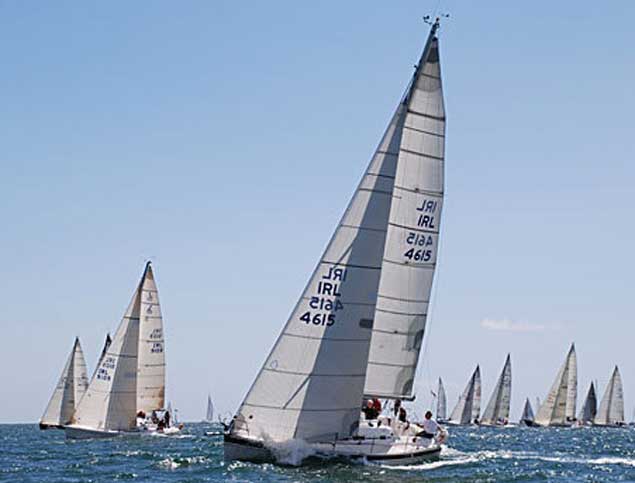 Summer comes to the East Coast - the Lambay Race at Howth, first sailed in 1904. 2018’s will be part of a family-friendly regatta at June’s Bank Holiday weekend, with the Lambay Race itself once again including the successful combination of the first part of an ISORA Race
Summer comes to the East Coast - the Lambay Race at Howth, first sailed in 1904. 2018’s will be part of a family-friendly regatta at June’s Bank Holiday weekend, with the Lambay Race itself once again including the successful combination of the first part of an ISORA Race
Because June’s Volvo Round Ireland Race from Wicklow has been moved from the traditional mid-summer weekend start to the last weekend of the month (presumably to avoid clashing with the finish of the Volvo Ocean Race itself at The Hague in The Netherlands where the stage is set from June 24th onwards), June is quite like old times with each Dun Laoghaire club staging its own Saturday regatta, while at national championship level the J/24s are descending on Foynes from June 8th to 10th, and the Sigma 33s are at the Royal St. George Yacht Club from June 22nd to 24th, while the National 18s in all their fascinating variations get in ahead of everyone with their Nationals at Baltimore on June 2nd/3rd.
Come the end of the month, and all eyes will be focused on Wicklow and the back-up port of Dun Laoghaire for the Volvo Round Ireland Race, counting 1.4 for the RORC points championship, and starting Saturday June 30th. It will be the 20th staging of this very special 704-mile Irish classic (it’s longer than either the Fastnet, the Middle Sea, the Bermuda, the Sydney-Hobart or the RORC Caribbean 600), but the 19th staging in 2016 was such a sensational event, with three MOD 70s and George David’s mighty Rambler 88 stealing the show, that 2018 is going to have to think of something different to make the proper impact.
In the end, its the steady, regular and frequent contenders who are the backbone of this race, and to emphasise this, the organisers are going to find which skipper has had the best accumulated result from the races of 2016, 2018, and 2020. Then at the prize giving after 2020’s race, that top scorer will be awarded a brand-new road-ready Volvo V40.
As to who will be doing the 2018 circuit, we do know already that the winner of the Volvo Dun Laoghaire-Dingle Race 2017, Paul O’Higgins (RIYC) with the JPK 10.80 Rockabill VI, has already signed up the formidable talents of Mark Mansfield of Cork who was on Dave Cullen’s chartered J/109 Euro Car Parks (aka Storm), which was the only Irish boat to win a class in the 2016 circuit.
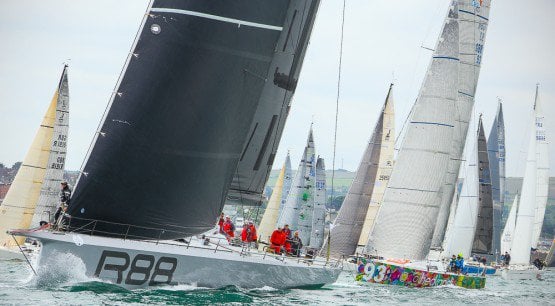 Here she comes….! How on earth George David’s Rambler 88 managed to come cleanly through the crowded start of the Volvo Round Ireland Race 2016 is a matter of wonder, but she did it like a hot and very swift knife through butter. Photo David O’Brien/Afloat.ie
Here she comes….! How on earth George David’s Rambler 88 managed to come cleanly through the crowded start of the Volvo Round Ireland Race 2016 is a matter of wonder, but she did it like a hot and very swift knife through butter. Photo David O’Brien/Afloat.ie
In July the emphasis moves emphatically to the south coast, and you can drive your new Volvo V40 there in expectation of a warm welcome, as the next big one up is Volvo Cork Week from July 16th to 21st. There’ll be an added sense of anticipation to this marvellous biennial sailfest, for it will be the last Cork Week before the big one in 2020, when the Royal Cork Yacht Club Tricentenary Cork Week will be just one of many major events celebrating 300 years of the world’s oldest yacht club.
Who knows, but maybe by 2020 they’ll be staging the Beaufort Cup as a major standalone event. What started as the germ of an idea in February 2016 for a sailing series among crews from the Defence Forces in the Volvo Cork Week of that July took off like a rocket, and 33 public agency crews in 12 mostly borrowed boats, representing just about every organisation and agency which is involved in serving the public, stretching its remit way beyond the defence forces.
Nevertheless it was a Defence Forces crew, skippered by Commandant Barry Byrne racing John Maybury’s J/109 Joker 2, which topped the leaderboard in a series which brilliantly captured genuine public interest. It was an astonishing success, and already entries are registered for 2018 with so much interest that you’d begin to worry whether there’ll be enough suitable boats available for loan to accommodate everyone.
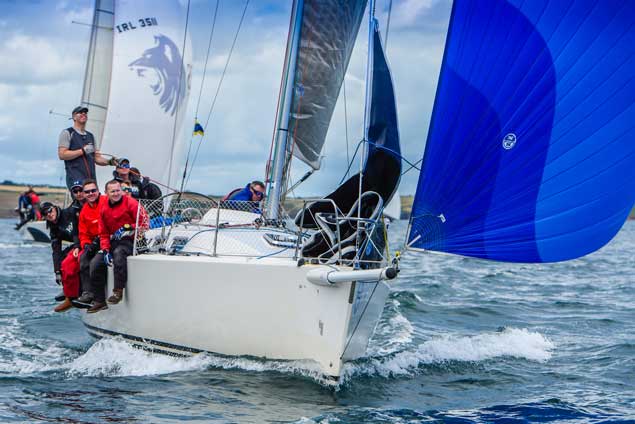 The Defence Forces’ crew, skippered by Commandant Barry Byrne and racing the J/109 Joker 2, were first winners of the Beaufort Cup which will continue as a feature of Volvo Cork Week in 2018. Photo Robert Bateman
The Defence Forces’ crew, skippered by Commandant Barry Byrne and racing the J/109 Joker 2, were first winners of the Beaufort Cup which will continue as a feature of Volvo Cork Week in 2018. Photo Robert Bateman
As it is, taking 12 highly competitive boats out of general competition impinged significantly on the mainstream Volvo Cork Week fleet in 2016, yet having the Beaufort Cup as part of Cork Week is something which adds to the allure of both events, so we sympathise with anyone who, in time, is going to have to square this particular circle. As it is, in 2018 the Beaufort Cup teams are going to be a fully-integrated part of Cork Week, racing the entire five days and savouring the unique Crosshaven Cork Week flavour, but nevertheless there are bound to be those who’ll wonder if extra mileage couldn’t be squeezed from having the Beaufort Cup as a standalone event.
As July veers into August, national sailing interest will swing two ways. Our potential Olympians will be shaping up for the intense contest at Aarhus in Dernmark, and at home in Ireland down in West Cork they’ll be shaping up for the allegedly non-intense Calves Week from Schull. In previewing the 2017 season, we described it as “a fun event with quite serious competitive undertones”, and this was then quoted with approval (and acknowledgement) by the Calves Week Chairman at a subsequent press launch, so if it ain’t broke, why try and fix it, Calves Week 2018 from 7th to 10th August (yes, four days, you’ll do more living in four days in West Cork than you will in a week elsewhere) definitely is a real fun event with quite serious competitive undertones.
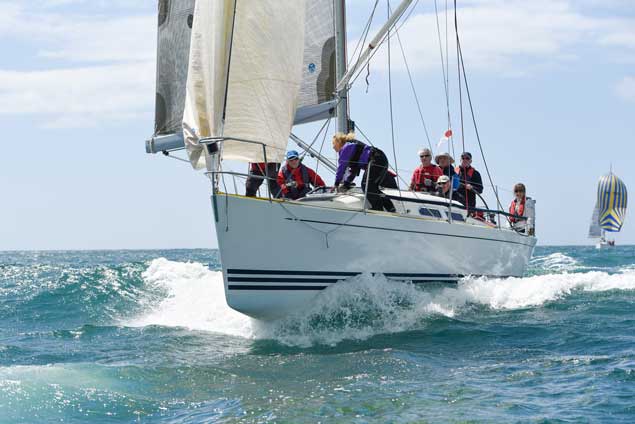 West Cork sailing at its glorious best – Calves Week action in August will be top of the bill in Schull. Photo: Robert Bateman
West Cork sailing at its glorious best – Calves Week action in August will be top of the bill in Schull. Photo: Robert Bateman
Back on the East Coast, meanwhile, the 1898-vintage Howth 17s are putting out the welcome mat on the weekend of August 10th to 12th for a Classics One-Design Regatta. It has been successfully done before with the Mermaids contributing much to the festivities, but this time the Young Gaffers of Howth hope that others – the Glens and Water Wags of Dun Laoghaire spring to mind – might also be interested. Certainly one of the unexpected successes of 2017 was the inclusion of a Classics Division in the Volvo Dun Laoghaire Regatta as part of the Bicentenary Celebrations for Dun Laoghaire Harbour, an idea which proved so popular there’s talk of doing it again in 2019, but it’s quite a challenge – getting venerable wooden boats and their characterful crews together is about as easy as herding cats.
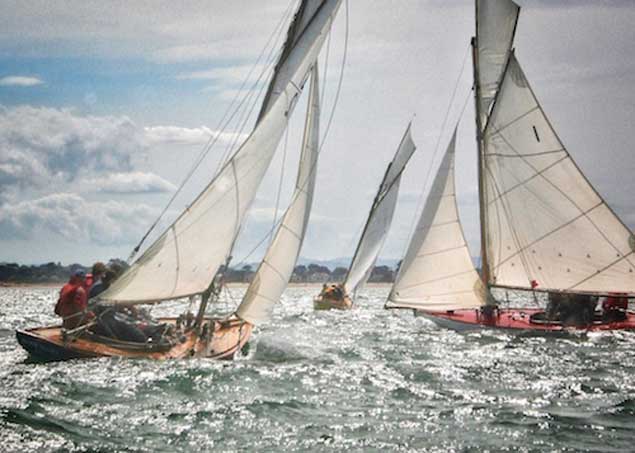 The 1898-vintage Howth 17s will be welcoming other classic One Designs to their home port on August 10th to 12th.
The 1898-vintage Howth 17s will be welcoming other classic One Designs to their home port on August 10th to 12th.
Normally August in a non-Fastnet year is a laid-back time for cruiser-racers when it’s possible to slip in one or two well-supported distance races in the Irish Sea, but August 2018 is going to be unprecedented, as both the WIORA Championship and the ICRA Nationals are going to be staged at Galway City from the 15th to the 18th of August.
Traditionalists will be ruffled by it being in August rather than June, and in the heart of the West Coast rather than at either end the old time-honoured basically Cork-Dublin axis. But ICRA Commodore Simon McGibney of Foynes and his team know that there is a strong core ownership of cruiser-racers along the length of the western seaboard (think of the 44 boats which turned out for the WIORA Championship in the Aran Islands at exactly the same time as the massive Volvo Dun Laoghaire Regatta 2017 was under way) and this fresh-look cruiser-racer gathering in Galway deserves every chance of success.
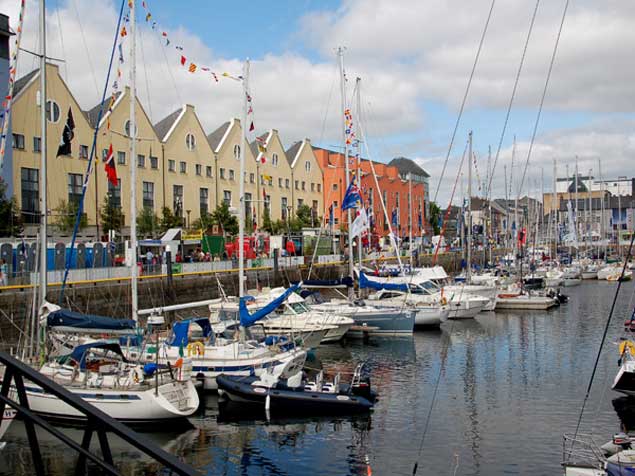 Regatta base in the hart of a hospitable city – Galway will be the hosting port for the WIORA Championship/ICRA Nationals 2018 from August 15th to 18th
Regatta base in the hart of a hospitable city – Galway will be the hosting port for the WIORA Championship/ICRA Nationals 2018 from August 15th to 18th
This preview of the cornucopia of events which 2018 has to offer is no more than a skimming of the peaks, with occasional in-depth glances at some curious corners of special interest. The sheer diversity of events, boats, locations and people involved is outlined in the detailed Irish Sailing schedule, and every sailor will find his or her favourite event there. But inevitably that detailed schedule is still far from complete. After all, in previewing 2016, even in January of that year we would not have been able to anticipate the huge success of the Beaufort Cup in July, for the then Minister for Defence Simon Coveney TD and his team didn’t have the inspired idea of the Beaufort Cup until late February.
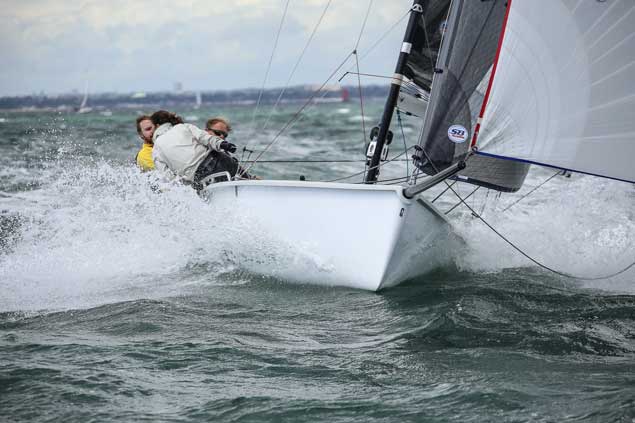 The SB20 Europeans promises some lively action on Dublin from August 28th – September 1st, at the Royal Irish Yacht Club hosted event Photo: David O'Brien/Afloat.ie
The SB20 Europeans promises some lively action on Dublin from August 28th – September 1st, at the Royal Irish Yacht Club hosted event Photo: David O'Brien/Afloat.ie
Nevertheless some things have been part of our sailing lives for decades, and every year September brings an entirely new mood, with established summer programmes drawing to a close, Autumn Leagues getting themselves into gear, and All-Ireland Championships to be raced.
The Juniors will be in the last weekend of September, venue and boat type still to be confirmed, but the Seniors are firmly in place at Lough Ree Yacht Club on the weekend of 13th to 14th October, to be raced in SB 20s.
There’s something very pleasing about the fact that the core stream of Irish sailing at home should reach its time-honoured concluding Championship of Champions in the heart of the country at a hospitable club which can trace its history back to 1770, with the event itself being raced in boats of a modern international class which has special Irish links. 2018 Irish sailing at home does indeed give every sign of being another memorable year, with a stylish and upbeat concluding championship.
 Fionn Lyden of Baltimore Sailing Club (left), with Irish Sailing President Jack Roy and crewman Liam Manning of Schull, and the historic All-Ireland silver salver he won on Lough Owel at Mullingar in October 2017. He will be defending at the All Irelands at Lough Ree on October 13th-14th 2018. Photo Irish Sailing
Fionn Lyden of Baltimore Sailing Club (left), with Irish Sailing President Jack Roy and crewman Liam Manning of Schull, and the historic All-Ireland silver salver he won on Lough Owel at Mullingar in October 2017. He will be defending at the All Irelands at Lough Ree on October 13th-14th 2018. Photo Irish Sailing
2018 SAILING HIGHLIGHTS
January Florida USA (Ft Lauderdale & Miami) – Olympic Classes Regattas
February 19th Antigua – RORC 600
March 12th Royal Cork YC - PY 1000
April 5th – 8th Irish Youth Pathway Nationals
April 21st ISORA season starts
May 25th – 29th Scottish Series, Tarbert
June 1-3rd Howth Regatta & Lambay Races
June 30th Volvo Round Ireland Race
July 16th-21st Volvo Cork Week with Beaufort Cup
July 30th – August 12th Hempel World Sailing Championship Aarhus, Denmark
August 7th-10th Calves Week, Schull
August 15th – 18th WIORA Championship & ICRA Nationals, Galway
August 28th – September 1st, SB20 Europeans, Royal Irish Yacht Club
September 7th – 15th September Laser Masters World Championships, RStGYC & NYC
September 29th-30th All Ireland Junior Championship (venue to be confirmed)
October 13th – 14th All Ireland Senior Championship, Lough Ree YC, sailed in SB20s
New Leader(s) Appointed for Volvo Ocean Race
Richard Brisius and Johan Salen have been appointed as President and Co-President of the Volvo Ocean Race, taking over from the outgoing chief executive, Mark Turner.
The duo founded Atlant Ocean Racing together and have worked with seven Volvo Ocean Race campaigns over the past 28 years, starting as sailors in the 1989-90 race, before finding success with team management, including winning efforts EF Language (1997-98) and Ericsson 4 (2008-09), as well as second place finishers, Assa Abloy (2001-02), and Intrum Justitia (1993-94). Most recently, the pair managed Team SCA, the all-female entry, in the last edition of the race.
Brisius is currently the CEO of the company owned by the National Olympic Committee, running Sweden's bid to host the Winter Olympics and Paralympics in 2026 and he will remain in that role.
Johan Salen has worked alongside Brisius on all of their previous Volvo Ocean Race projects. He will take a leading role in both operations and in devising a strategy for the future of the event alongside the current leadership team.
The current Volvo Ocean Race leadership team will remain in their roles.
Ballyholme's Bill O'Hara Expected To Lay Short Course for Volvo Ocean Race In–Port Duel
Principal Race Officer of the Volvo Ocean Race, Bill O'Hara from Ballyholme Yacht Club in Northern Ireland, is anticipating the course will be short, with at least three, and possibly up to four, laps. The second in-port race will be held in Lisbon starting at 14:00 UTC this afternoon.
Seven teams will take the start of the In-Port Race. This is the second in the VOR In Port Race Series. In Alicante, MAPFRE beat Dongfeng Race Team with Vestas 11th Hour Racing completing the podium.
The forecast is for moderate 10 to 15 knot south–westerly winds.
The target time for the race is 60–minutes.
For that wind direction, the length of the race course is likely to be confined by the banks of the Tagus River,
With so many manoeuvres required on the short course, boat handling is sure to be a determining factor for success this afternoon.
After his VOR race officer duties are completed this weekend, O'Hara fies to Mexico to meet up with Ireland's World Sailing delegation at the World Conference in Mexico as outlined by Afloat.ie here.
Damian Foxall Podcast: Volvo Ocean Race Crew 'Shenanigans', Marine Debris, What it Takes to Make it Offshore & Who to Call if You Hit a Whale
Ireland’s Sailor of the month for October, Damian Foxall talks (play podcast below) about Sunday's start of the Volvo Ocean Race 6,000–mile leg two to Capetown. From the deck of Vestas 11th Hour Racing, he tells about crew 'shenanigans' aboard the VOR 65s and admits Dong Feng and Mapfre are two very serious competitors in a one design fleet where the gains between boats are very small. Ireland's high seas superstar also admits the fleet is waiting with 'bated breath' for news of the new race CEO.
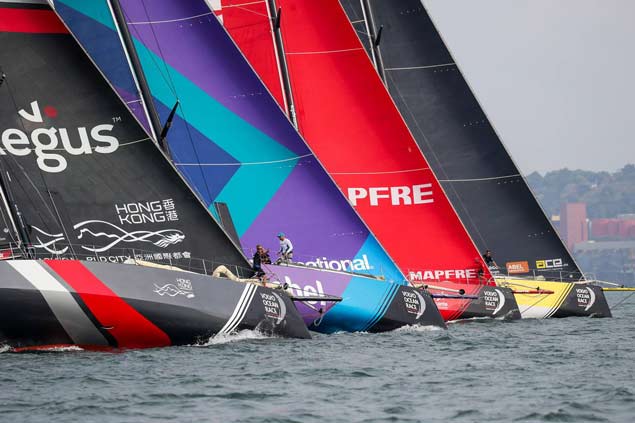 VOR Teams that established themselves early with solid crews have already shown they have an advantage. According to Foxall, Dong Feng and Mapfre are two very serious competitors Photo: VOR
VOR Teams that established themselves early with solid crews have already shown they have an advantage. According to Foxall, Dong Feng and Mapfre are two very serious competitors Photo: VOR
Foxall recalls last month's leg one win and sets out the clear objectives of Vestas 11th hour racing that includes so much more than just winning his second VOR title. Endorsing the VOR's marine debris campaign, the County Kerry offshore racer maintain's that it is 'unacceptable' for any sailing event to be using single use plastic bottles. There's news too about why marine clothing firm Musto has reduced its product packaging by 80% and who to call if you hit a whale...
Finally, Foxall has advice for Nin O'Leary, Annalise Murphy and all the other up and coming Irish offshore racers keen to follow in his wake...and why, as Foxall maintains, Ireland has not yet realised its great marine resource potential.
Listen in to the podcast below...
Damian Foxall Fact file
Date of birth: 7 March 1969
In: County Kerry, Ireland
Legs sailed in this edition: Leg 1
There’s not much that five-time Volvo Ocean Race veteran and passionate ocean conservationist Damian Foxall hasn’t done when it comes to sailing. He won the Volvo Ocean Race as part of Groupama in 2011-12, set a round-the-world speed record onboard G-Class catamaran Cheyenne, and took victory in the two-handed Barcelona World Race in 2008, adding all that to his record as the first ever non-French entry to grab a leg win at the Solitaire du Figaro in 1997. Now, he returns to the toughest test of a team in professional sport looking to lift the trophy for a second time.
Previous Volvo Ocean Races:
2014-15 Dongfeng Race Team
2011-12 Groupama sailing team
2008-09 Green Dragon
2005-06 Ericsson
2001-02 Tyco
Dubarry of Ireland is the official supplier to Team Brunel and Team Scallywag in the 2017–18 edition of the Volvo Ocean Race, providing high performance offshore footwear to the crews.
The Irish sailing boots have been developed over a number of decades bringing important design details from Formula one racing tyres to provide the ultimate outsole grip for offshore sailing footwear.
Leather is combined with GORE-TEX® technology to offer protection in the most demanding of environments. The involvement by Dubarry with VOR teams continues a long proud history of association with this race since the early Whitbread days.
 Dubarry's Crosshaven boot
Dubarry's Crosshaven boot
Built for the ocean, say Dubarry, the Crosshaven Boot is designed for high performance when facing the most challenging of elements. Crosshaven’s most striking feature is the integral gaiter, which is made with a lightweight, high abrasion, water repellant fabric and adjustable draw-cord collar that secures foul weather gear and prevents wash back.
It also houses a drainage mesh for optimal water release and features high-visibility bands. It is thermally insulated, utilising a 350g GORE-TEX® Duratherm membrane for extra warmth and waterproofness, combined with a thermally-lined footbed, which provides the boot with full insulation. Reinforced toe and heel parts utilise Dubarry’s unique D-Chassis System.
This two-part foot support system uses a moulded RPU frame that minimizes heel pronation by adding extra support, protection and control. Crosshaven also has finger pulls for easy foot entry and ExtraFit™ sizing.
In Ireland, Dubarry Crosshaven is available from leading chandleries including Viking Marine and CH Marine
Leg One Win Puts Foxall's Team Vestas Into Volvo Ocean Race Lead
As Afloat.ie reported, Irish sailor Damian Foxall and the Vestas 11th Hour Racing crossed the finish line in Lisbon at 1408 UTC ahead of their competitors by a few hours earning 8 points and are now the leaders of the Volvo Ocean Race. They led the 7-day race since the first night staying ahead of the other seven boats through the Strait of Gibraltar, around the island of Porto Santo, and north to Lisbon via a virtual waypoint added by the Race Committee mid-leg.
“Can’t argue with the results,” said skipper, Charlie Enright upon finishing in Lisbon. “For us, it has always been the process and improving every day. We prioritized getting the right people and this provides us with a lot of confidence. I can’t say enough about the squad on the boat and the ones on the shore.”
“To kick it off this way is a strong sentiment to the team,” added Team Director and Co-Founder, Mark Towill. “We have a long way to go for sure, and this is a great way to start the event.”
This is technically back-to-back ocean leg wins for the American duo, Enright and Towill. The pair along with their fellow US sailor, Nick Dana, won the final leg of the last edition onboard Team Alvimedica. This is the first leg win for Vestas, and for a Danish flagged boat in the history of the Volvo Ocean Race.
The team is now in Lisbon for one week participating in outreach events with the local community, an In-Port Race, Pro-Am racing, and preparing for the 7000-mile leg to Cape Town, South Africa that starts on November 6th.
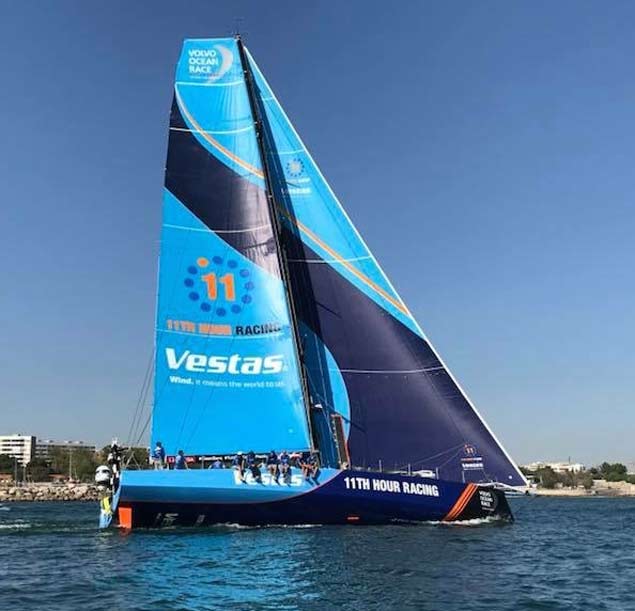
The Race to Win
Vestas 11th Hour Racing led for the majority of the 1650 nm course that took the seven teams from Alicante, Spain to Lisbon, Portugal.
"We had a good leg. And that’s due to the strong shore team preparation with Chris Bedford, our meteorologist, Anderson Reggio for navigation support, and Vestas’ meteorology team. We had a plan and could be proactive instead of reactive," said Simon Fisher (SiFi), winner of the last Volvo Ocean Race as navigator.
The first night the crew took a risk by sailing close to the shoreline of southern Spain hoping for wind coming off the mountains not seen on weather forecasts. The gamble paid off as they were the first in and out of the Strait of Gibraltar, an area known for high winds, shipping traffic, and a narrow path for maneuvers.
According to SiFi, "we then got fired out of Gibraltar at 30 knots. We saw as high as 35 knots and we gybed back and forth quite a few times to stay in the pressure which is definitely exhausting for the team."
By Day 2, the sailors extended their lead 25 miles from the second place boat, but it was short-lived as it shrank to 6 miles in just a few hours, as they were the first to sail into a lighter pressure system.
"We had good scheds and bad scheds," said Charlie Enright, referring the position reports delivered to the team every six hours. "It's frustrating to see the others take a bite out of your lead."
The vexations started to wane as the crew rounded the island of Porto Santo still in the lead, and a downwind drag race ensued north to a virtual mark 250nm away. The race committee added the mark after Day 2 to extend the course to align with the intention of a 7-day leg.
After turning the virtual mark, the team continued to extend attributing their speed to the sail choice and crew work. While all the teams have the same sails onboard, it is up to the individual crews to decide which of the seven headsails are the optimal combination for varying conditions.
"We are fortunate enough to have a well-rounded crew who can jump into any position on the boat, whether that is driving, grinding, or trimming," said Team Director, Mark Towill. "That allows everyone to stay fresh and execute our navigation plan."
"We are not talking about the finish onboard yet," said young Australian sailor, Tom Johnson just 24 hours before the finish. "No one is taking a back seat, we are just all doing our job."
The last 24 hours were tough as the crew faced shifting light winds, a traffic separation scheme that limited their navigation, and 4 miles of upwind sailing in a narrow river to the finish, but in the end the crew recognizes this is only beginning of a longer race that will take them around the world over the next 9 months.
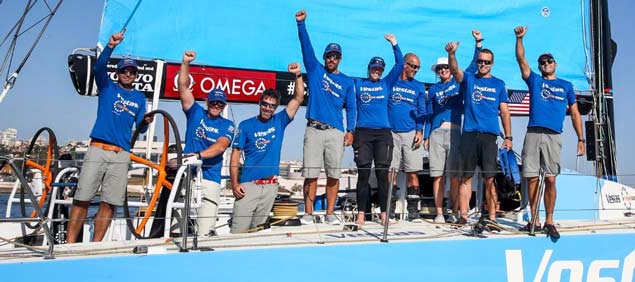 Team Vestas celebrate leg one victory, Damian Foxall is fourth from right Photo: Jesus Renedo/Volvo Ocean Race
Team Vestas celebrate leg one victory, Damian Foxall is fourth from right Photo: Jesus Renedo/Volvo Ocean Race
Life Onboard
The first leg of the race was an exhausting all-out sprint for the team. Executing multiple maneuvers in the initial 36 hours means there little sleep for the crew. Then in the light air, the monotony of waiting for wind is a mental game the teams must push through to be ready for the next situation.
When not keeping the boat going fast, preparing food, washing dishes, and maintenance are tasks the sailors share onboard. Fresh food only lasts for the first few days; then they switch to freeze-dried meals. The crew partook in Meatless Monday, an international campaign to reduce the impact the meat industry has on the environment on the first day out at sea. "We are enjoying Mediterranean veggie pasta," said Mark Towill, "it is one simple way of lowering our carbon footprint and is part of our commitment to sustainability."
The boat also had to overcome a few systems failures onboard during the leg. A broken water pump the first day left the crew without fresh water until boat captain, Nick Dana, was able to fix the issue. He explains, "it's not like we can go out and get a new one, everything must be fixed onboard, but that's the Volvo Ocean Race." Repair and reuse is another key element of sustainable living.
Then on the evening of Day 4, skipper Charlie Enright, felt the performance of the boat "just wasn't right" so he went below only to discover a disconnected water ballast hose filled the yacht with 800 liters of water. The crew bailed the water and repaired the hose, luckily, not losing too much speed in the process.
It’s not all work onboard a Volvo Ocean 65. On the morning of Day 6, race rookie and British sailor, Hannah Diamond took a moment to soak it all in: "It's been a really nice sunrise and had a couple of pods of dolphins come past, so couldn't ask for more really."




























